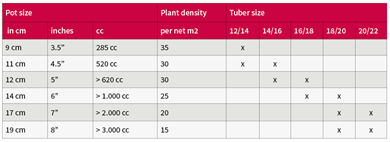Cultivation guide for potted calla liliesThe most important factors to think about when growing potted calla lilies (botanical name: Zantedeschia) are soil medium, irrigation and greenhouse climate. Other aspects to consider are disease prevention and nutrients. Here are a few guidelines that will contribute to a successful crop of potted calla lilies. Tubers:Zabo Plant supplies tubers that can be planted directly. Each tuber has several active shoots and has been prepared according to the our special method. If you intend to plant the tubers in series we recommend not storing them for longer than 3 to 4 weeks. Calla lily tubers should be stored in a dry, well-aired space (to prevent mold) at temperatures between 58 and 60 °F (13 - 15°C). Calla lily tubers do not withstand cold well and should never be stored where they may be exposed to frost. Potting soil for potted calla lilies:Choose a well-draining potting soil with a pH value of 6.5. The potting soil should also be sterilized. Zabo Plant recommends using a mix that consists of 60 - 80% coco peat for an optimum result. A mix commonly used for calla lilies contains 60% coco peat, 20% fine Finnish peat and 20% coarser Finnish peat. To ensure a thorough drainage and a sufficiently high oxygen content we discourage a too high percentage of fine peat. Pot size versus tuber size:Calla lilies can be planted in pots of all different sizes. With regard to the type of pot used, we recommend using pots with a lip at the bottom, as this will raise the pot slightly off the ground. This will promote air circulation underneath the pot. Depending on the pot size, you can plant one tuber per pot, or multiple tubers in the same pot. Please refer to the table below as a guideline: If you are using bigger pots, please refer to the following figures when planting multiple tubers per pot: As not all cultivars will thrive equally when multiple tubers are planted in the same pot we recommend discussing your cultivation program with us before you start. We will be happy to give you custom advice. Planting:Calla lilies produce roots at the top of the tuber, which then grow downwards around the tuber towards the bottom of the pot. This is why it is essential that the tubers are planted with the shoots at the top. After planting, the tubers should be covered with at least 1.5 - 3 inches of potting soil (3-5 cm). Greenhouse temperature:After planting, the pots containing the tubers can be moved to a rooting cell or directly into the greenhouse. The best starting temperature is between 63 and 68˚F (17 - 20˚C). Make sure that the pots do not dry out while the plants are in their root development phase! Taking into account that the roots will first start to grow at the top of the pot (above the tuber), ensure that there is enough moisture in the top part of the pot to prevent the newly developing roots from drying out. Greenhouse climate and lightingCalla lilies thrive when they get enough light, which they need to produce flowers. The successful cultivation of calla lilies depends on a sufficient amount of light, in combination with the right greenhouse temperature, nutrient and fertilizer program and irrigation. It is therefore necessary to continually monitor and adjust the temperature in the greenhouse and ensure the best possible humidity conditions. This will result in proper plant growth and promote the evaporation of excess moisture. Calla lilies prefer a relative humidity of 65 - 75%. Prevent a relative humidity below 50% and avoid considerable fluctuations in humidity during the daytime. Calla lilies thrive best when cultivation variables are kept constant. | Irrigation:Potted callas prefer overhead irrigation. It is essential that the sprinkler system is regularly inspected, particularly to ensure an even distribution of water. Watch out for dry or excessively wet spots, as this may cause root and overall growth problems. Nutrients and fertilizers:Potting soil is often supplemented with approximately 20 oz of NPK (12-10-28) per yd3 (800g NPK (12-10-28) per m3) as a basic fertilizer. Sufficient iron and magnesium levels are also essential, as is achieving the right balance between nitrogen and potassium. Too much nitrogen will result in longer stems and weaker plants. We advise adding nutrients every time the plants are watered. Growth regulation:Bonzi (Paclobutrazol) is often used to as a growth regulator (to inhibit excessive growth). Factors that determine the ultimate size of a plant include the temperature, the light intensity, the humidity of the potting soil and the variety itself. Standard recommendations may deviate from what is best for a particular cultivar, but can be considered as good basic advice. The first Bonzi treatment can be given when the shoots are 2” - 4” (5 - 10cm). We recommend treating the plants with Bonzi in the morning, one day after the last watering. Bonzi can be applied by drenching the pots. This will ensure that the growth regulator is properly absorbed by every pot. As shoot growth may differ from pot to pot, we recommend sorting the pots by shoot length first and/or marking the pots immediately after treatment. Recommended dosage:Apply 1 cc Bonzi (4 grams/liter Paclobutrazol) by drenching the pots with approximately 50 cc water per pot. (A solution of 2fl oz Bonzi to one gallon of water (which comes down to 60 ppm Paclobutrazol. Depending on the variety, the pots should be drenched with 1 - 3 fl oz (60 ppm).) Crop protection:Erwinia Carotovora, Pythium and Rhizoctonia - most commonly caused by a cultivation problem - are the most common diseases to affect calla lilies. Well-draining soil and a good disease prevention program are important factors in preventing premature plant death. In order to grow healthy plants under good cultivation conditions it is essential that you plant healthy tubers and use clean tools. If your plants begin to shed their outer leaves this could indicate Rhizoctonia. This can be combated with fungicides such as Amistar (Azoxystrobine). Check the plants at regular intervals by taking a few of them out of their pots at random and inspecting their roots. Insects:It is important to keep your plants free from insects to ensure a consistently high quality. Check regularly for aphids, trips and whiteflies. If you would like more information about this, don’t hesitate to contact us. DisclaimerAlthough the content of this cultivation guide has been compiled with the greatest possible care, it is only a means of providing general, obligation-free advice and cannot serve as a guarantee for healthy plants. The influence of cultivation conditions on the growth of plants, and additionally the effect of specific agents and methods can vary depending on the climate. Zabo Plant does not accept any liability whatsoever for any damage arising from the use of the information in this cultivation guide. |
CallaNova by Zabo PlantKorte Belkmerweg 1-A | The CallasPotted Callas Cultivation Guide Cut Flower Callas More infoAbout Zabo Plant
| Contact us
| Social media |





